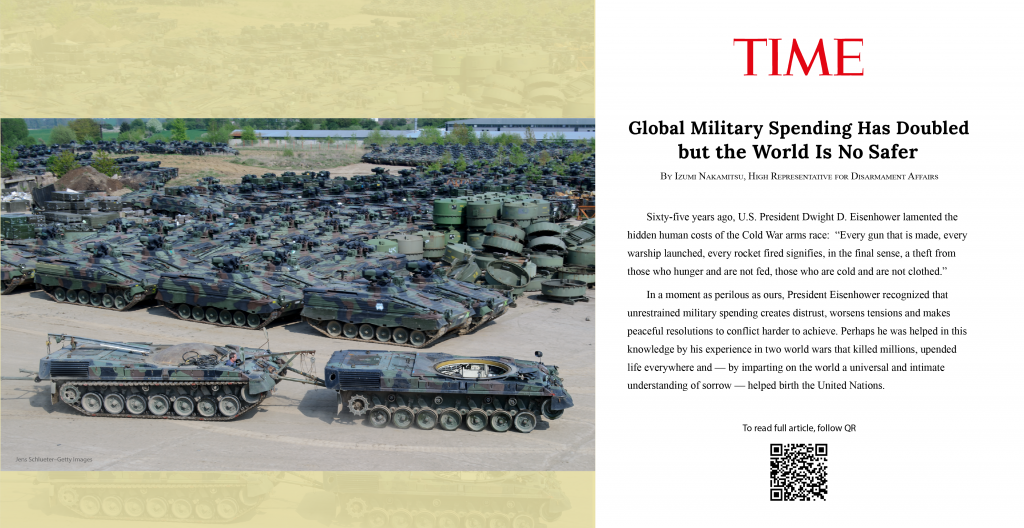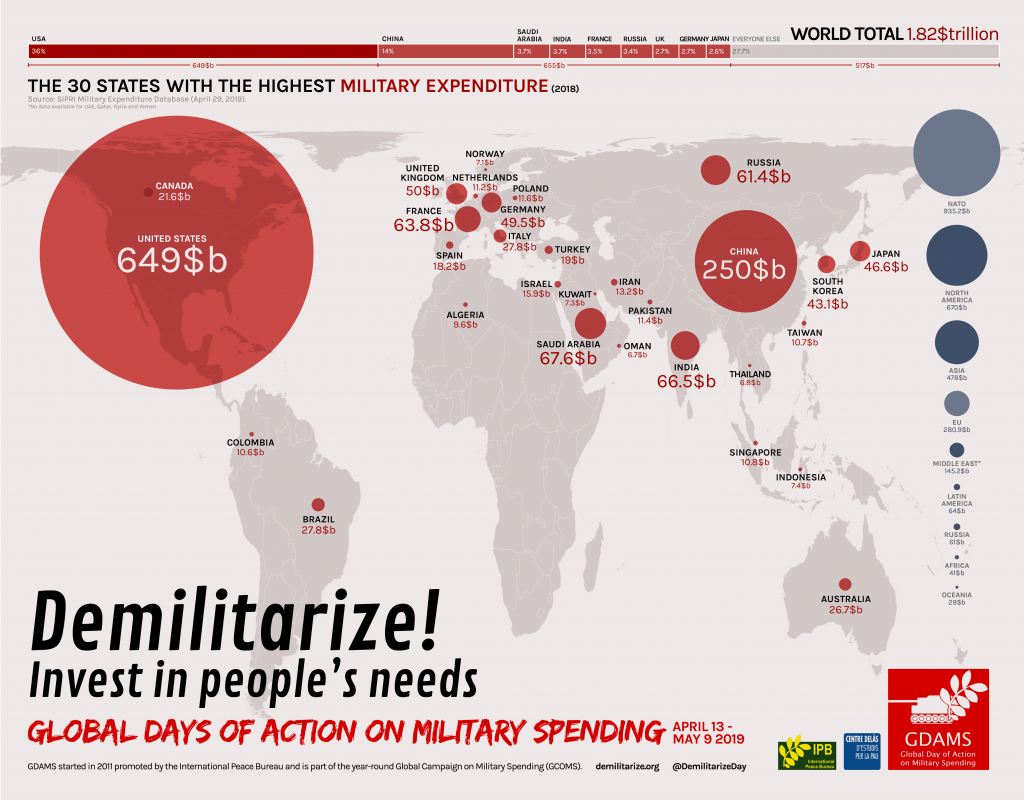Why Demilitarize?
The facts
According to the Stockholm International Peace Research Institute (SIPRI), the world’s military expenditure for 2018 was $ 1822 billion, the highest figure reported since the end of the Cold War. It also means 83 billion more than in 2017, passing from a 1.1% to a 2.6% increase in real terms. This trend of militarizing and stockpiling weapons is led by the USA, a country which has increased its military spending to $649 billion, 4,6% more than in the previous year, remaining thus by far the largest spender in the world and accounting for 36% of global military budget in 2018. The US and its NATO allies account, once again, for more than half of all military spending in the world, having reached $ 963 billion.
The European Union is the second largest military spender accounting for 15% of the global military spending, above China, which has also increased its expenditure by 5% to $250 billion. China is followed in SIPRI’s ranking by Saudi Arabia, India, France, Russia, the UK, Japan and South Korea.
The 10 biggest spenders account for almost three quarters of the world’s total.
The amount of money spent on the military sector in 2018 equals $4.9 billion a day or $235 per person.
Militarization is accelerating at an alarming rate at a time when it should be drastically reduced in order to tackle the grave challenges humanity is facing. The world therefore diverts huge amounts of resources to the military sector, leaving basic needs such as food, health, education, employment and environmental challenges greatly under-funded. The imbalance between defence and social or development aid budgets is striking in most countries. Yet despite the global economic crisis and a general public opinion opposed to war and militarization, there are few real signs that governments are at this point ready to initiate a radical shift in spending priorities.
The global military spending accounts for 2,1 % of global GDP, an amount which could instead be used to alleviate human suffering and realise comprehensive programmes such as the UN Sustainable Development Goals. According to the SIPRI the reduction of only the 10% of military spending would be enough to achieve major progress on some key SDGs, supposing that such funds could be effectively channeled towards these goals.
The Global Commission on Adaptation to climate change calculated in a report that an investment of $1.8 trillion (€1.6 trillion) across five key areas (early warning systems; climate-resilient infrastructure; improved dryland agriculture; mangrove protection; water resources resilience) over the next decade would yield a return of $7.1 trillion in economic benefits.
$1.8 trillion is exactly what the world spent in the military only in 2018.
According to SIPRI, military expenditure includes spending on ‘defence ministries and other government agencies engaged in defence projects; paramilitary forces when judged to be trained, equipped and available for military operations and military space activities’.
The expenditures include:
– All expenditures on current personnel, military and civil
– Retirement pensions of military personnel
– Social services for personnel and their families
– Operations and maintenance
– Procurement
– Military research and development
– Military construction
– Military aid (in the military expenditures of the donor country).
For reasons of comparability between states, SIPRI data on military spending does not include civil defence, current expenditure for previous military activities, veterans’ benefits, demobilization, conversion of arms production facilities or destruction of weapons.
The omission of such data means that large sums are not taken into account. In the USA, the costs of veterans’ benefits and the military share of interest on the national debt amount to 18% of government spending. We can conclude that the true overall costs of the military
worldwide must be substantially higher than those often referenced.
However, without detailed reporting on these additional costs in each country a complete global tally is impossible.
For More Information:
- IPB’s publications:
Opportunity Costs: Military Spending and the UN Development Agenda
Whose priorities? A guide for campaigners on military and social spending
Warfare or Welfare? - The Stockholm International Peace Research Institute (SIPRI)
- The United Nations Report on Military Spending
- Disarmament – A Basic Guide (see chapter 2 on Global Military Expenditures)
- United Nations Office for Disarmament Affairs (UNODA)

Demilitarizing…

We must counter the tendency to engage in an arms race / military bloat vicious spiral in which states justify their increased military spending to counter that of their neighbours, while they reduce social budgets (education, health employment) and don’t allocate enough resources to diplomacy, cooperation, humanitarian and development aid or peacebuilding.
The idea that all 67 wars occurring nowadays in the world will be solved by the old-fashioned deterrence politics is absurd. Increasing military spending to obey NATO diktats is extremely misguided and dangerous. The answer should instead be a combination of diplomacy, transparency, resort to legal arbitration and economic and environmental cooperation, in order to develop a spirit of cooperation, solidarity, just distribution and shared stewardship of scarce resources.
Our argument is that there is no magic recipe for resolving this problem; there are many factors that have to be considered, but we are absolutely convinced that diplomacy and non-violent solutions will yield much better results than pouring more billions into the military, which has ostensibly failed over history.
Nonviolent alternatives are abundant, morally superior, drastically less costly, far more appealing to the great majority of people in most countries, and thus strategically more effective. They of course should never be mistaken for inaction or capitulation in the face of oppression or terror.
We, as active members of global civil society, need to combine our voices and efforts with others in order to name, protest and change the injustice military spending represents and perpetuates. We cannot overstate that militarization is profoundly rooted in a predatory economic system, which is destroying life-support systems and generating increasingly obscene levels of violence and inequality. It is therefore essential to incorporate an intersectional and all-encompassing analysis that can connect the dots between different trends and emergencies and, on the basis of that diagnosis, offer alternatives that are peaceful, sustainable and just.
The aim of this campaign is to raise awareness on the excessive amount of public money spent year after year on the military system all over the world. Our growing community intends to impact at the budget decision-making, especially at the national level, so that resources are reallocated to human and environmental needs.

